Framework Desktop review: A powerful AI PC, made with love
 At a glance
At a glance
Table of Contents
Expert’s Rating
Pros
- Extremely detailed assembly instructions
- Simple but configurable
- Powerful AMD Ryzen AI Max+ chip inside
- An overall sense of quality
Cons
- Memory is soldered and is not upgradable
- Attaching the SSD takes some nerve
Our Verdict
The Framework Desktop DIY Edition is a thoughtfully engineered small-form-factor desktop PC that is both an entry point into enthusiast computing as well as a powerful AI desktop in its own right.
Price When Reviewed
This value will show the geolocated pricing text for product undefined
Best Pricing Today
Best Prices Today: Framework Desktop

The Framework Desktop DIY Edition is unique: a do-it-yourself desktop without the complexity of building from scratch, forming a compact, personalized “AI workstation.” If you’re nervous about a less-familiar brand, don’t be. Framework obsesses over details, from manuals to helpful hints etched into the materials themselves. Multiple photos show how to tighten a thumbscrew–that’s how comfortable they want you to be.
I can point to a few things that I thought needed improvement: soldered memory, a beta driver bundle that should be finalized by the time you buy it, and a top panel which didn’t clip in as easily as I would have liked. Inserting the SSD stressed me out a bit, too.
But Framework’s eye for customization (colored tiles you can design and install yourself, plus your choice of I/O) lends itself to fun and productivity. The AMD Ryzen AI Max+ (Strix Halo) chip inside is slightly out of the ordinary, with its do-everything design. I have high praise for the Framework Desktop, and think you will too. Let me tell you why.
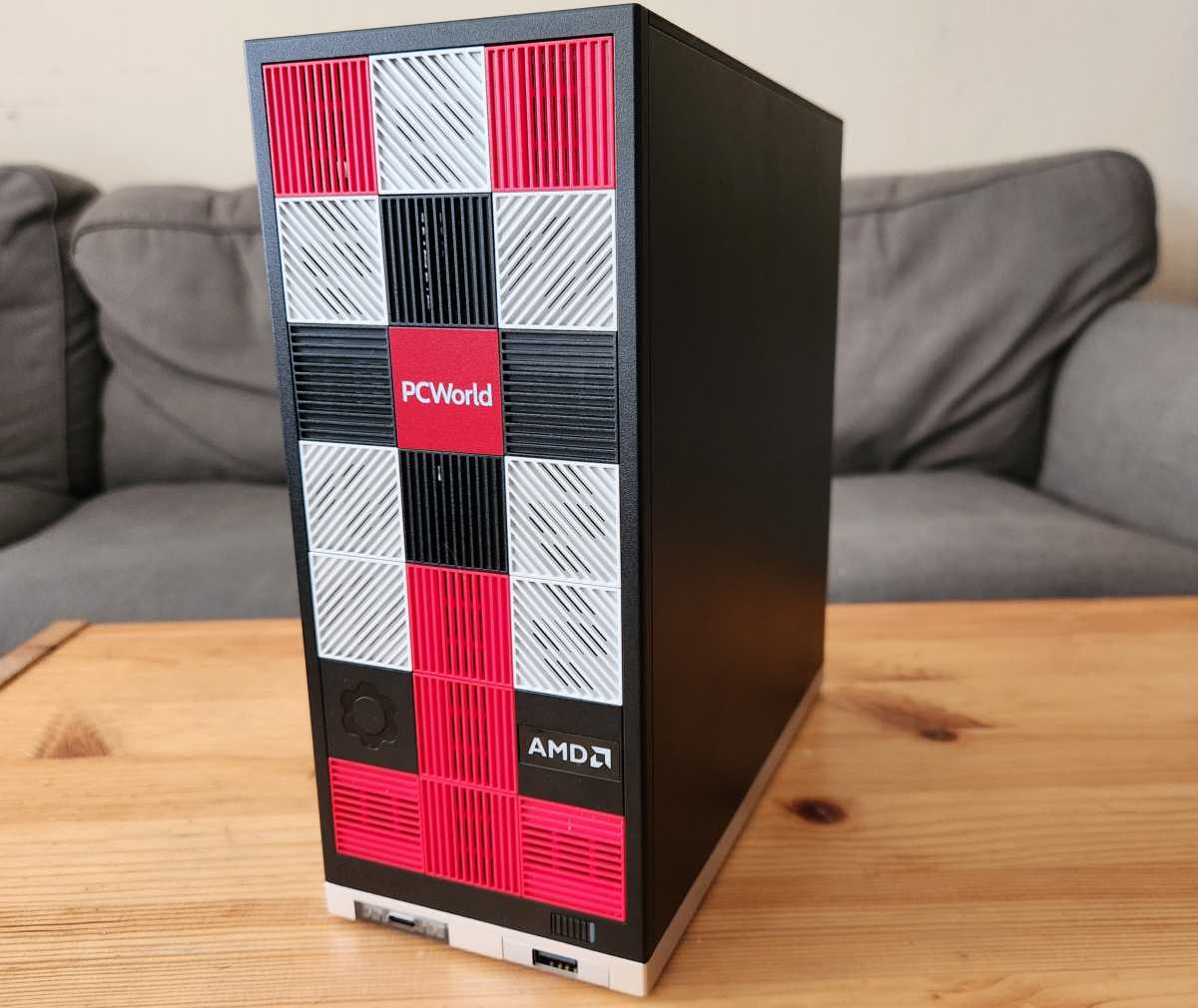
Mark Hachman / Foundry
Framework Desktop: Specs
Framework lets you pick and choose which components you want to add… sort of. Our review model was a DIY Edition, which asks you to build the PC yourself. Framework also sells an entirely pre-built model, too.
For each Desktop, you’ll need to select which Ryzen AI Max processor (with an integrated GPU) you prefer: the Max 385, an 8-core chip with 32GB of LPDDR5x memory attached, up to the Max+ 395, a 16-core processor with a whopping 128GB of memory. Each processor is pre-mounted on the Framework mainboard, inside the Desktop’s case and with a power supply. It’s all upgradable, with one exception: the memory is soldered directly to the motherboard.
Because of this, prices begin at $1,099 for AMD’s Ryzen AI Max 385 and climb to $1,999 for the Max+ 395 option. While this DIY Edition allows you to stop and contribute your own storage, you probably won’t.
So start tacking on the extras: WD Black SSDs sold by Framework (between $69 and $699 for 500GB to 8TB) serve as primary and optional secondary storage, up to $199 for a Windows 11 Pro license, and options like a translucent side panel, custom tiles, and so on add cost. You’ll need to pick one of three 120mm CPU fans, too, or supply your own. Our review model (detailed below) cost a little over $2,500.
To recap: assuming you supply your own SSD and operating system, you can spend as little as $1,099 for the Framework Desktop. But you’ll probably want to buy some storage from Framework, too. Just don’t forget the optional expansion cards ($11-$39 apiece) and the colored tiles ($10-$15 for a pack of seven monochrome tiles, and $5 apiece for logo tiles). They’re optional but make the Framework fun.
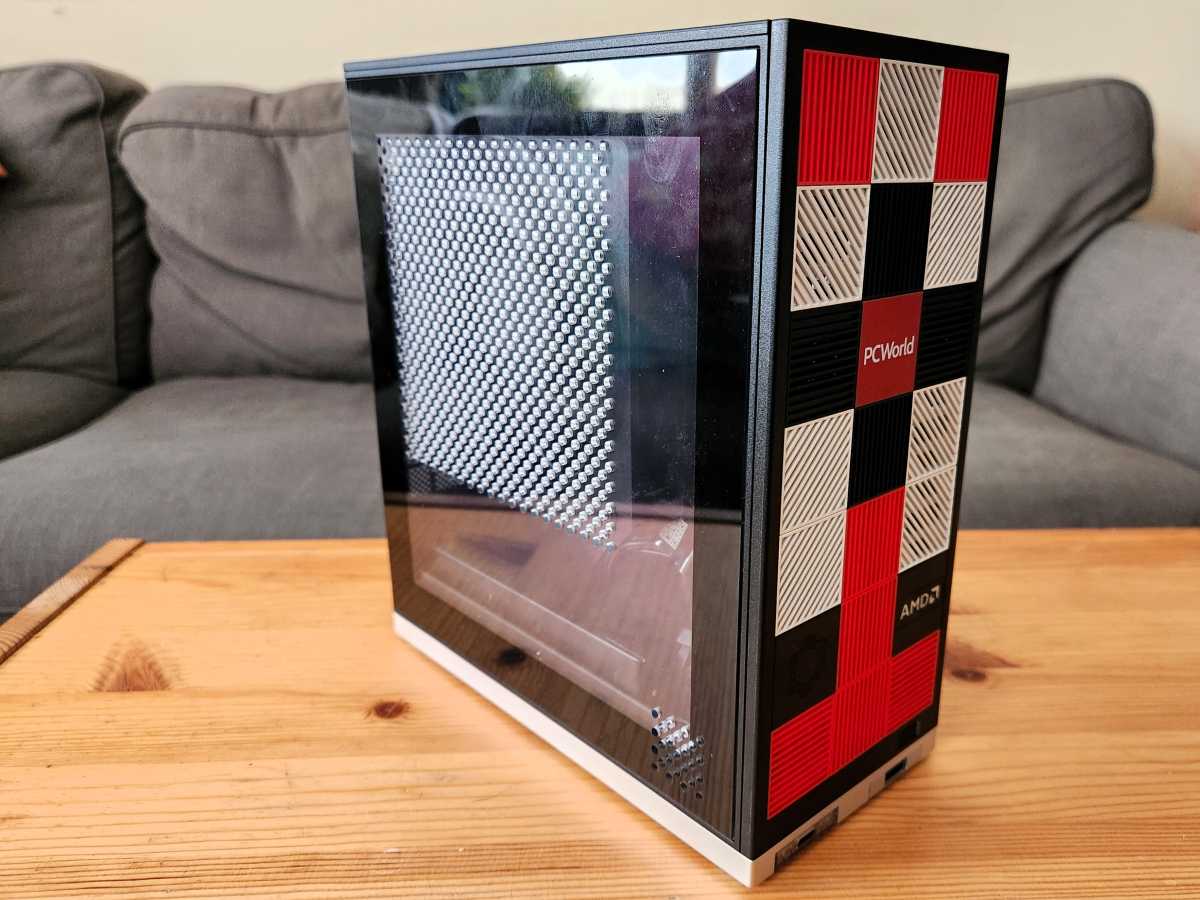
Mark Hachman / Foundry
Framework’s Framework Desktop configuration page spells it all out. Be aware, though, that Framework makes the Desktop in batches, and the page shows the Framework Desktop currently sold out through sometime after October.
(As of press time, Framework had not issued any updated guidance on President Trump’s proposed chip tariffs of 100 percent. Check the Framework tariff blog for updated information.)
- Processor: AMD Ryzen AI Max 385/Max+ 395
- Graphics: Radeon 8060S (integrated)
- NPU: Yes, 50 TOPS
- Memory: 32GB (Max 385)/64GB (Max+ 395)/ 128GB (Max+ 395), LPDDR5X-8000, soldered to motherboard
- Storage: 500GB to 8TB NVMe PCI 4.0 SSD (2TB as tested)
- Power supply: 400W, Gold (110V), or Silver (230V)
- Ports: 2 USB-C (USB 4 40Gbps), 2 DisplayPort 2.1, 2 USB-A 10Gbps, HDMI 2.1, 5Gbit Ethernet, 3.5mm jack
- Security: none integrated
- Wireless: Wi-Fi 7, Bluetooth
- Operating system: User-supplied (Windows 11 Pro as tested)
- Dimensions: 8.9 x 8.1 x 3.9in.
- Weight: 6.8 pounds
- Color: Black
- Price: Starting at $1,099, $2,515 as tested
It’s not just for tinkering — this machine can legitimately run the latest AI models locally, something few desktops this size can do.
Framework Desktop: Build process
Our review unit of the Framework Desktop arrived in what almost appeared to be a “flat pack” box like you’d find from Ikea. (Framework asked how it should be customized; I responded with an image of our PCWorld logo and a request to “make it cool.”)
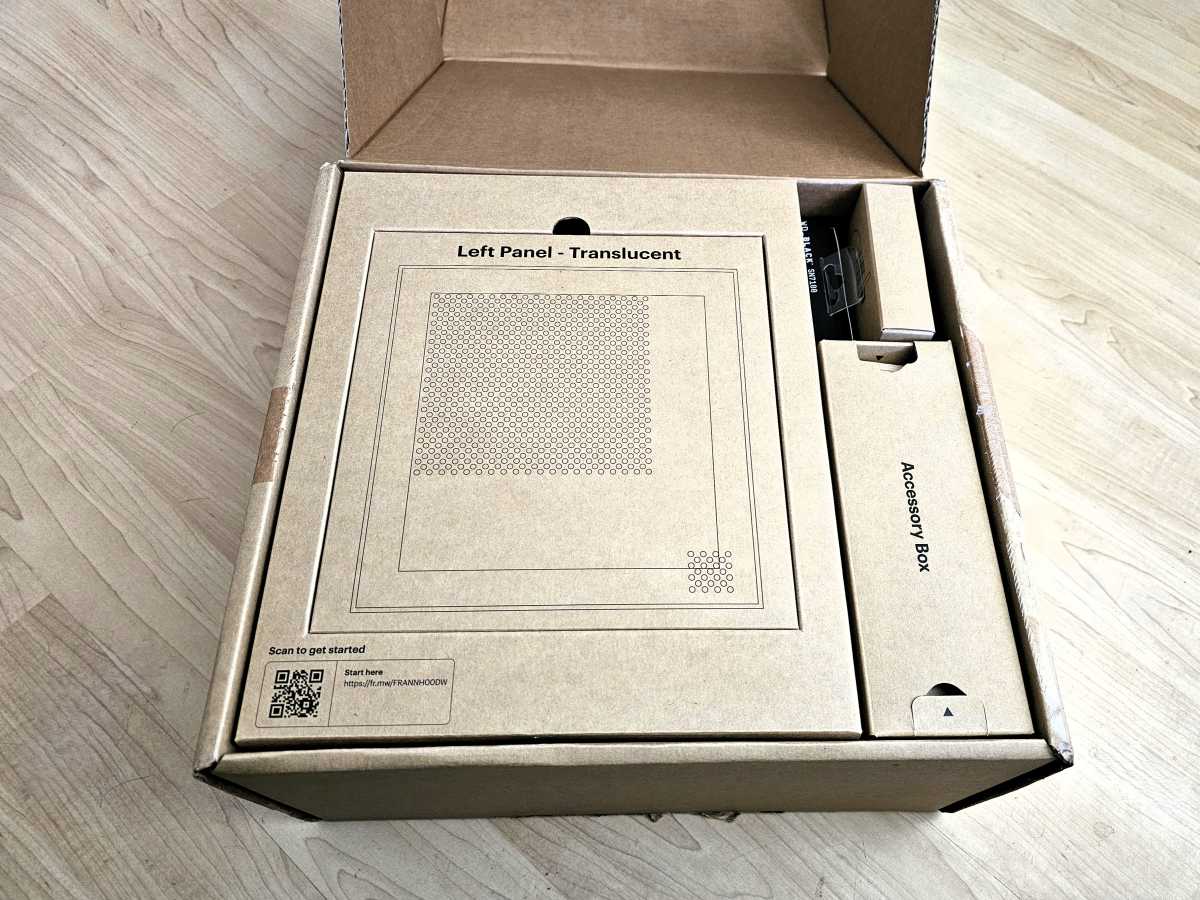
Mark Hachman / Foundry
Each component came separately boxed, with the top box bearing an HTML glyph and link to the online quick-start build instructions. This process was extremely easy, insanely detailed, and leaned into the part of my psyche that appreciates precise, well-documented instructions. If you’ve ever struggled through an Ikea manual, your soul will be soothed by the Framework guides, guaranteed.
The Framework Desktop measures 8.9 x 8.1 x 3.9 inches, which translates into 4.5 liters of space. The Desktop will fit inside an ordinary backpack, though not as conveniently as a laptop.
As my build article notes, Framework’s DIY Edition really doesn’t give you that much to actually do, besides insert the SSD, attach the fan, and mount the side panel, tiles, and expansion cards. Normally, “building” a PC involves placing the CPU on the motherboard, applying thermal paste and a cooler, and inserting/attaching the motherboard to the case. Not here.
Framework does this all for you already, mounting the mini-ITX Framework Mainboard inside the metal chassis, along with a FlexATX 400W power supply with either a Gold (110V) or Silver (230V) rating. You will have to install the SSD yourself; the primary M.2 slot is well within the case, making it a bit challenging to install. A secondary slot is on the bottom of the motherboard and easily accessible via a side panel.
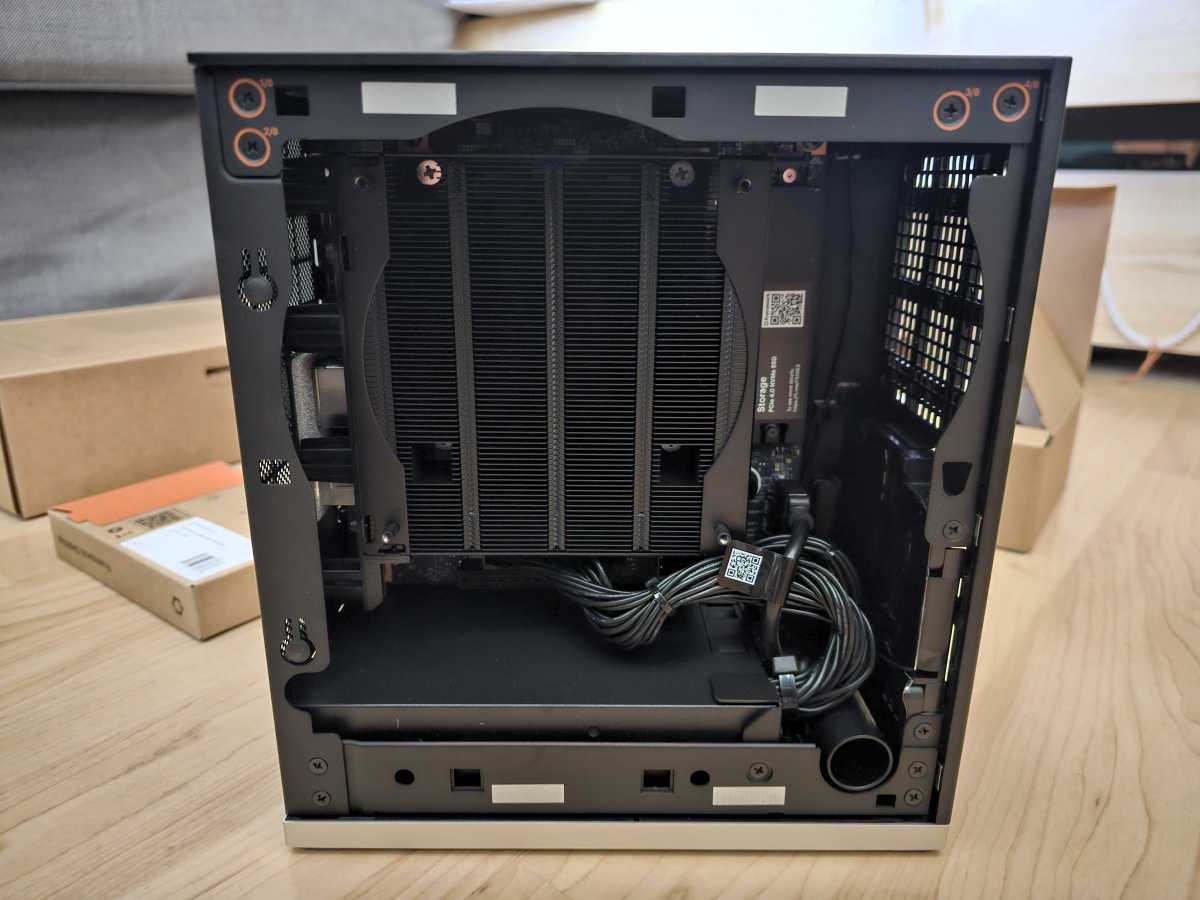
Mark Hachman / Foundry
Framework’s specifications page goes into more detail than you might need but will probably appreciate, such as the acoustic noise and airflow ratings of the three optional CPU fans from Cooler Master and Noctua down to the dimensions and design of the heatsink. Speaking of airflow, the Desktop operated quietly with very little noise. Inside, all of the cables were tightly wrapped and out of the way.
Framework even goes so far as to publish other guides that you may never use, such as removing the Framework mainboard from the Framework case and installing it in an entirely new, custom case. If you’re interested in a more detailed discussion of the build process, consider reading my separate article.
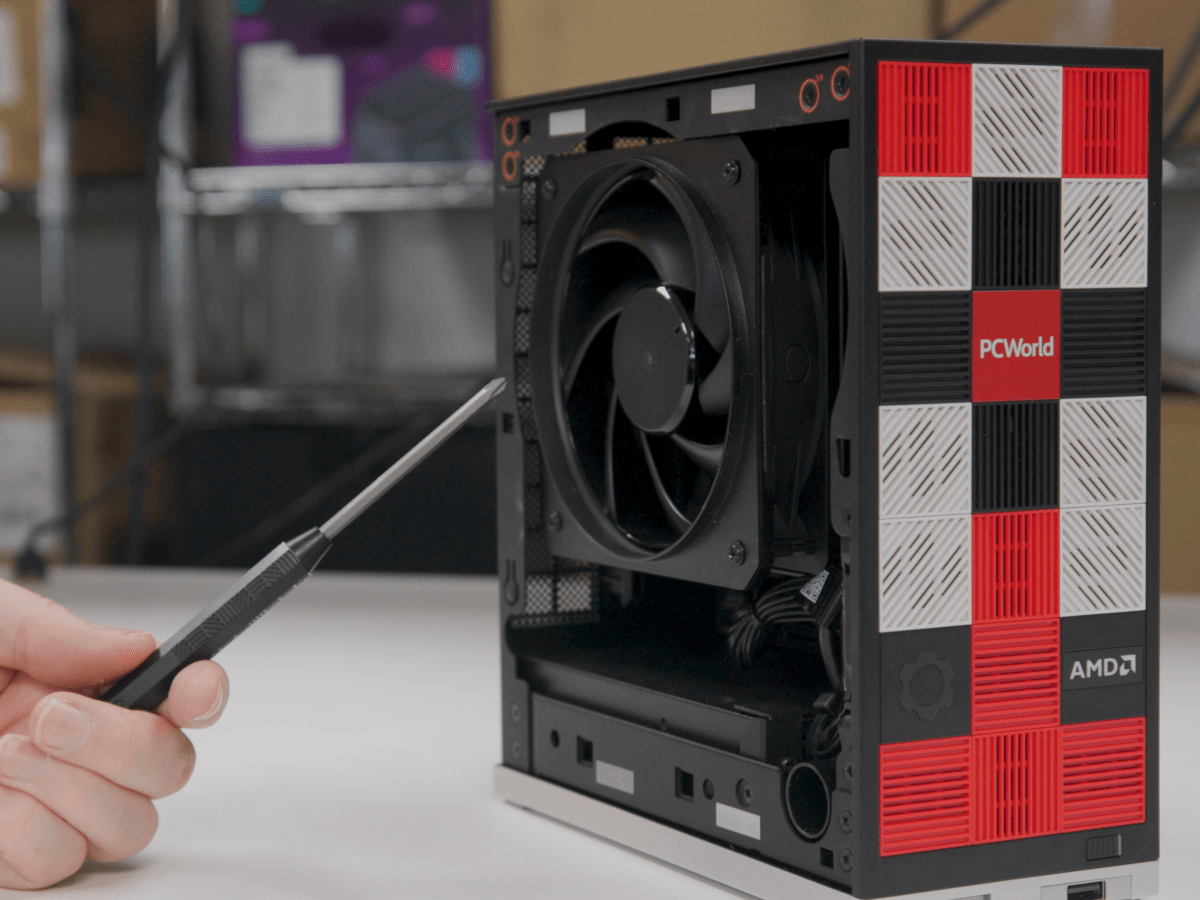
Alex Esteves / Foundry
Framework says that the whole process will take you about 45 minutes, which sounds about right. Remember, that includes installing an operating system like Windows, which can easily take 20 to 30 minutes by itself.
My installation also shipped with beta drivers that AMD hadn’t fully signed off on. That not only meant that I had to install a driver package (for Wi-Fi, audio, and the like) as well as the operating system, but that they affected the performance as well. (Framework said the night before this review published that it had begun shipping finalized drivers.)
Since AMD’s Ryzen AI Max CPU is a mobile part, the chipset is integrated into it. That certainly helps the Desktop from an upgradability standpoint, as that aspect is taken care of.
Most of the side panels attach to via a combination of magnets and/or tabs, which went on smoothly, but required a bit of fiddling. The only issue I had was with the top panel. Framework used some sliding tabs to hold the top panel down, along with two thumbscrews. For whatever reason, the tabs either refused to slide in for minutes at a time, or did so immediately. I’d encourage Framework to find another solution.
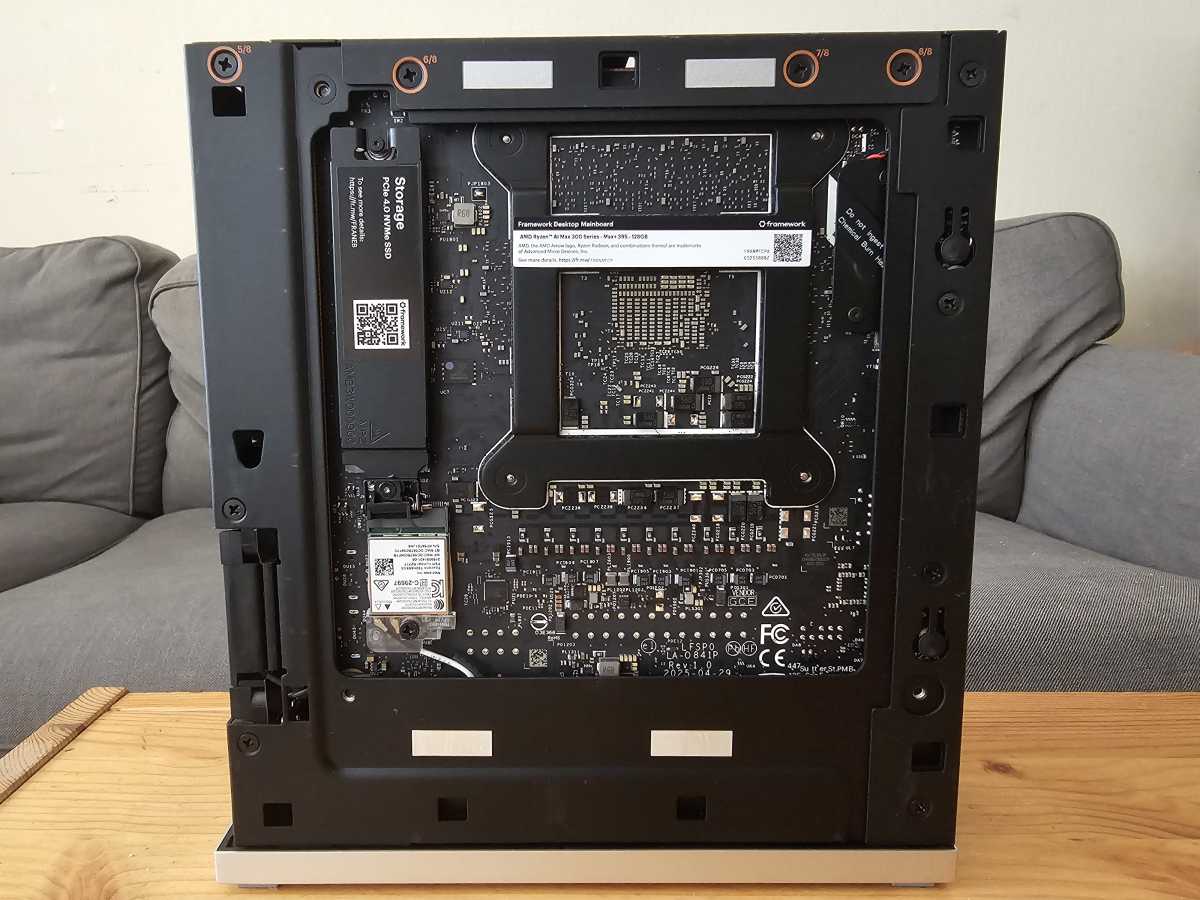
Mark Hachman / Foundry
Don’t forget to order and install the colored tiles! Those are the soul of the Framework desktop, and come in various colors. Each tile (save for some of the custom, logoed tiles) has a few narrow slits for airflow. I thought of these as a dust screen of sorts until I noticed that air is sucked in through the grillwork on the side panel, pushed across the CPU using the CPU fan, then pushed out through the front and back.
Many people like to decorate their laptops using stickers. I hate doing so, but really had fun using the colored tiles to create a fun little mosaic highlighting the PCWorld custom tile that Framework commissioned.
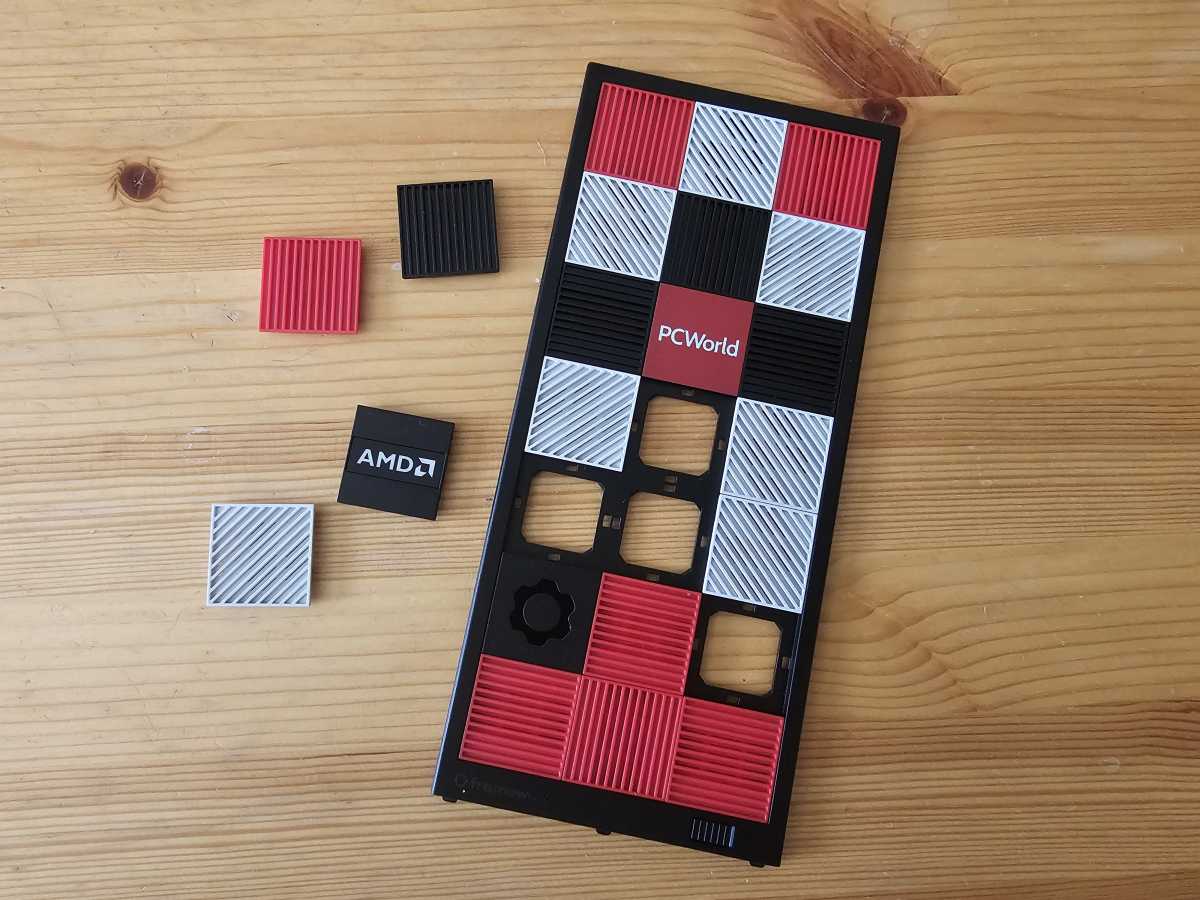
Mark Hachman / Foundry
Again, the tiles are optional. Airflow is sucked in through the side grille and pushed out through the front and back, so be sure and reserve most of the slatted tiles for the top of the front panel to avoid blocking the airflow as it exits the case.
Framework asked us for a custom tile design with our PCWorld logo. It doesn’t extend consumers the same opportunity, at least yet.

Mark Hachman / Foundry
The Desktop’s rear ports include an HDMI 2.1 port, a pair of DisplayPort 2.1 ports, two USB4 connections, a 5Gbit Ethernet port, two USB-A ports, and a 3.5mm headphone jack. Thunderbolt ports used by Thunderbolt docks are just branded USB4 ports, so the two USB4 ports will connect to a USB4 or Thunderbolt 4 dock at 40 Gbps speeds.
Framework also allows you to buy multiple I/O connectors, known as Expansion Cards, which plug into two front receptacles. Each expansion card is essentially a passive USB-C dongle, and you can buy USB-A, Ethernet, headphone jacks — everything except for a display port. Each expansion card slots into the slot, then latches using a small lock on the underside of the case. Everything worked perfectly in terms of performance and swapping them in or out.
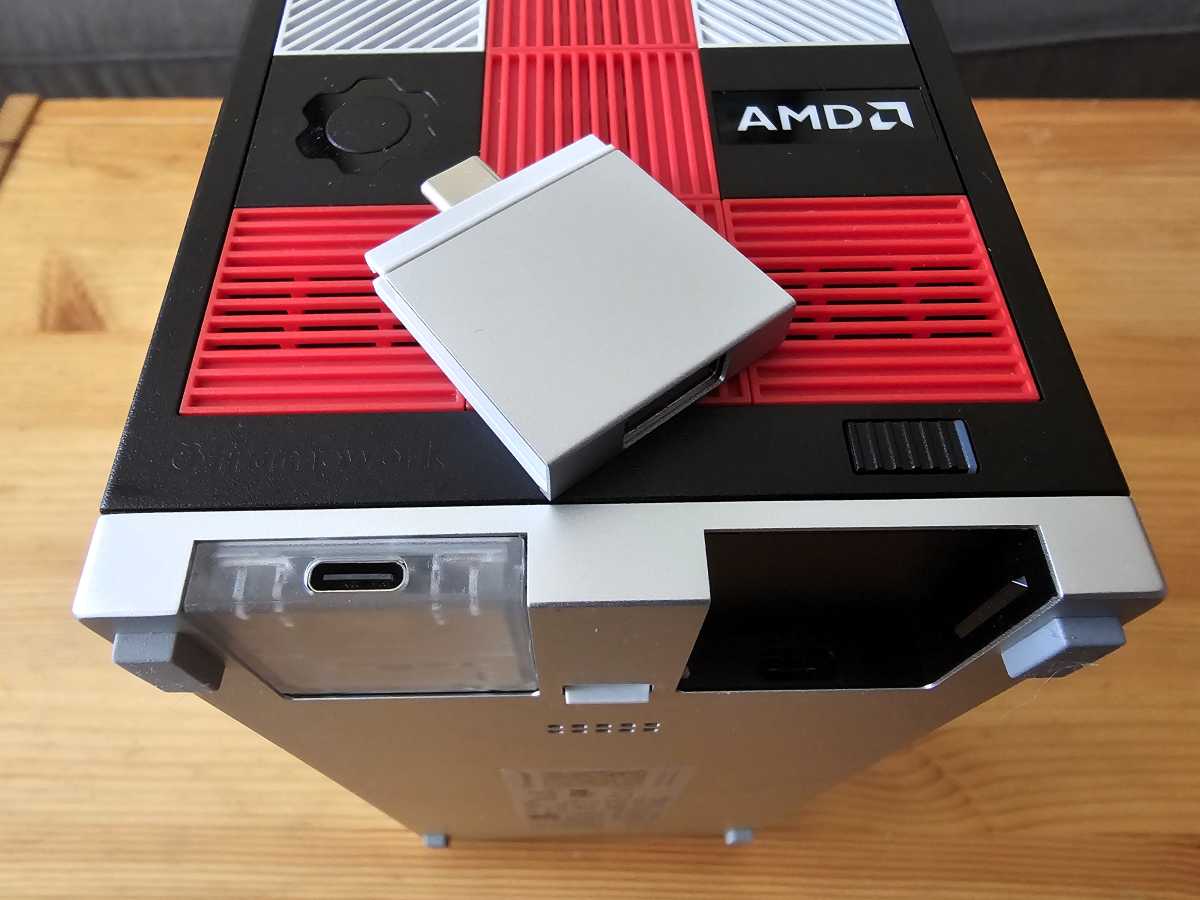
Mark Hachman / Foundry
Framework Desktop: Performance
Testing the Framework Desktop is a challenge, if only because it can do so many things well. It’s both a productive (and quiet) desktop machine, but its integrated GPU is powerful enough for after-hours gaming. But the real reason the Framework Desktop may exist is because of its massive amounts of VRAM, which lends itself to downloading and running various iterations of AI, including AI art and chatbots, or LLMs.
AMD’s Ryzen AI 395+ supports a TDP of 55 watts, existing as both a mobile processor as well as a desktop CPU. To date, the only other machines to use AMD’s chip have been gaming tablets like the Asus ROG Flow Z13 or more traditional clamshell notebooks like the HP ZBook. Manufacturers have begun to refer to some of these as AI workstations, even though they don’t really mirror the big, bulky workstations of old. Framework’s Desktop sure doesn’t.
Desktop graphics cards ship with dedicated video RAM; in laptops, VRAM is allocated a different way. The fact that the Ryzen AI Max (Strix Halo) is a mobile processor is more important than you might think.
In AI, the video RAM attached to a GPU is essentially the RAM the AI algorithm uses. Laptops with Intel chips inside divvy up the system RAM equally between the GPU and the operating system: an Intel Core Ultra notebook with 32GB of RAM uses 16GB to execute programs and assigns 16GB to the GPU as VRAM. AMD does it differently: the BIOS assigns what VRAM it thinks it needs, but you can manually adjust it, something that you can not do with most Intel-based laptops.
Why is that important? Out of the box, the Framework Desktop wasn’t really optimized to take advantage of its massive amounts of RAM. Remember, Framework issued reviewers early drivers. As it turned out, those drivers didn’t deliver the best performance, especially on AI applications. AMD (coincidentally or not) published a beta driver to its Adrenalin software package, which allows the 128GB of RAM attached to the AI Max+ 395 to assign 32GB to the operating system, leaving a whopping 96GB as VRAM for graphics or AI.
Basically, what I’ve done is first compare the Framework Desktop to a number of existing “Strix Halo” PCs, all in the mobile space, to demonstrate its comparative performance. Next, we’ll compare the Framework Desktop to a number of gaming laptops — not so much to point out which is better, but to allow you to mentally classify where the Desktop and its Strix Halo chip sits in the grand scheme of things. Which gaming laptops does it compare to? I think that’s as useful as anything else.
For the first batch of comparisons, we’re pitting the Framework Desktop against the HP ZBook Ultra G1a, essentially a direct comparison with a Ryzen AI Max+ Pro 395 chip inside and 128GB of RAM; the $2,299 Asus ROG Flow Z13 gaming tablet with a Ryzen AI Max+ 395 but with only 32GB of RAM; and a version of the $1,699 Asus ZenBook S16, with a much lower-performance Ryzen AI 9 HX 370 and 32GB of RAM.
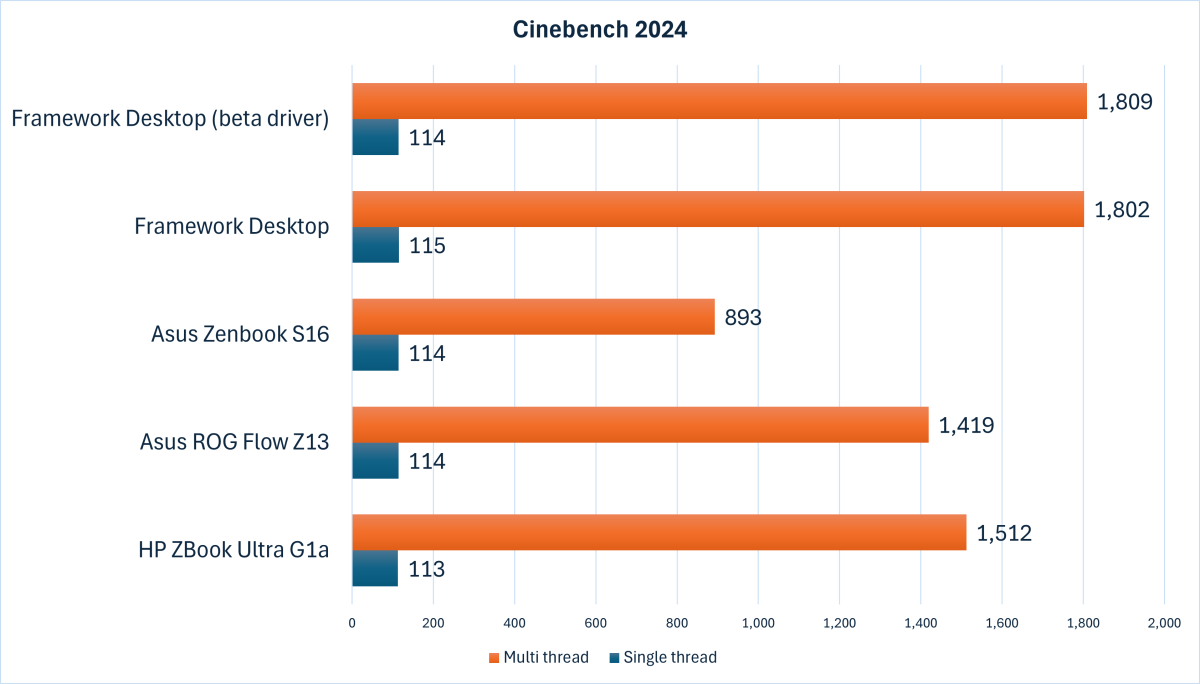
Mark Hachman / Foundry
In certain applications, we’d expect that the better cooling of the Desktop might make a difference; in other benchmarks, the additional VRAM might give it an edge. Cinebench is a purely CPU-driven benchmark, which can be run on a single thread — where performance is statistically equal — and across all of the cores and threads.
Given that three of these devices use very similar CPUs, you might expect that these numbers would be virtually identical. But there’s a 19.6 percent increase from the ZBook to the Framework Desktop in CPU performance alone. In a case like this, I would attribute the difference in terms of the Desktop’s superior cooling.
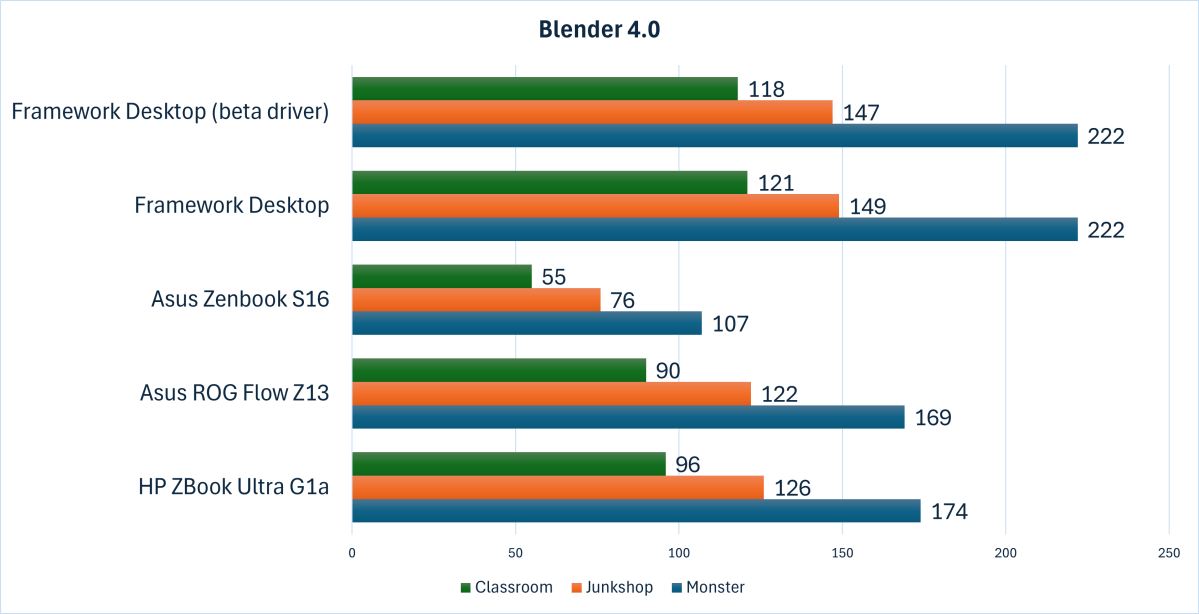
Mark Hachman / Foundry
I didn’t have personal access to all of these devices; we maintain a reviews database, and certain devices are shipped back and forth. In this case, we did have access to the Blender benchmark, which uses the open-source 3D creation tool to generate three different scenes. This test measures both the CPU and GPU.
Again, we’re seeing a similar division between all four devices. Looking solely at the Monster benchmark (shown in blue), the Desktop improves by 27.6 percent over the HP ZBook, with no change to the scores because of the improved driver. That will change.
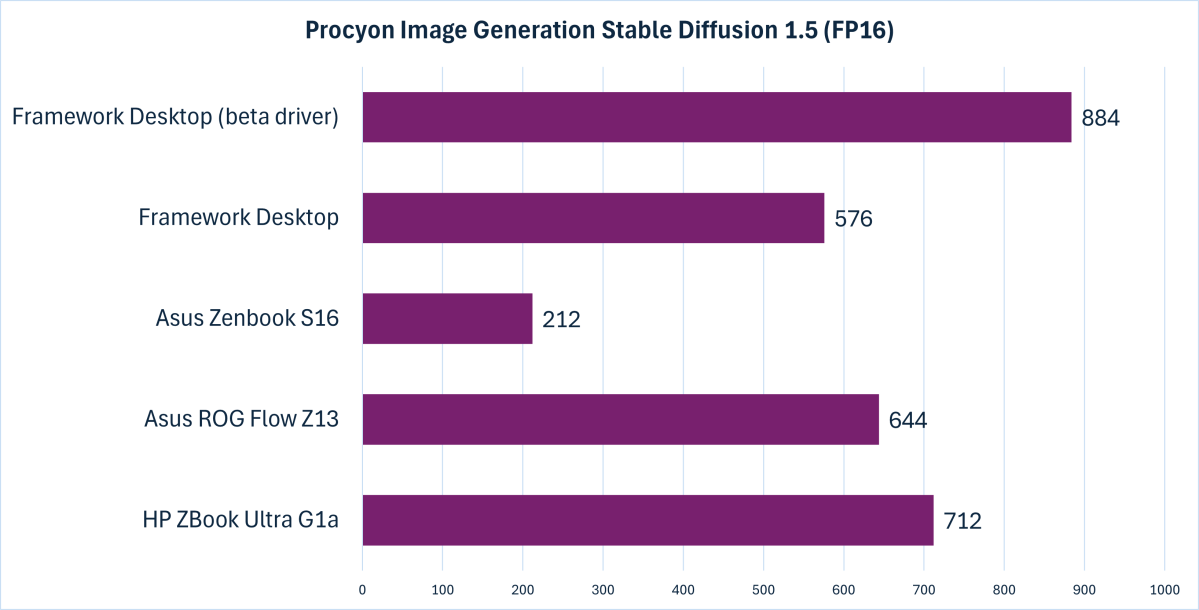
Mark Hachman / Foundry
This was when I started to ask questions about whether Framework’s driver made a difference. Procyon’s Image Generation test simply creates a series of 16 1024×1024 images, using a common prompt. Framework’s Desktop wasn’t slow to do so, but it fell behind a couple of notebooks, which made me raise my eyebrows. As it turned out, AMD’s driver made more RAM available to the processor and the image generation algorithm.
Here, the Framework Desktop improves by 26 percent over the HP ZBook, roughly consistent to how it behaved in the Blender benchmark. The Framework Desktop generated an image about every ten seconds, which is pretty good without a discrete GPU. Obviously, you’ll see better (or worse) performance running AI art on other models not used by this benchmark.
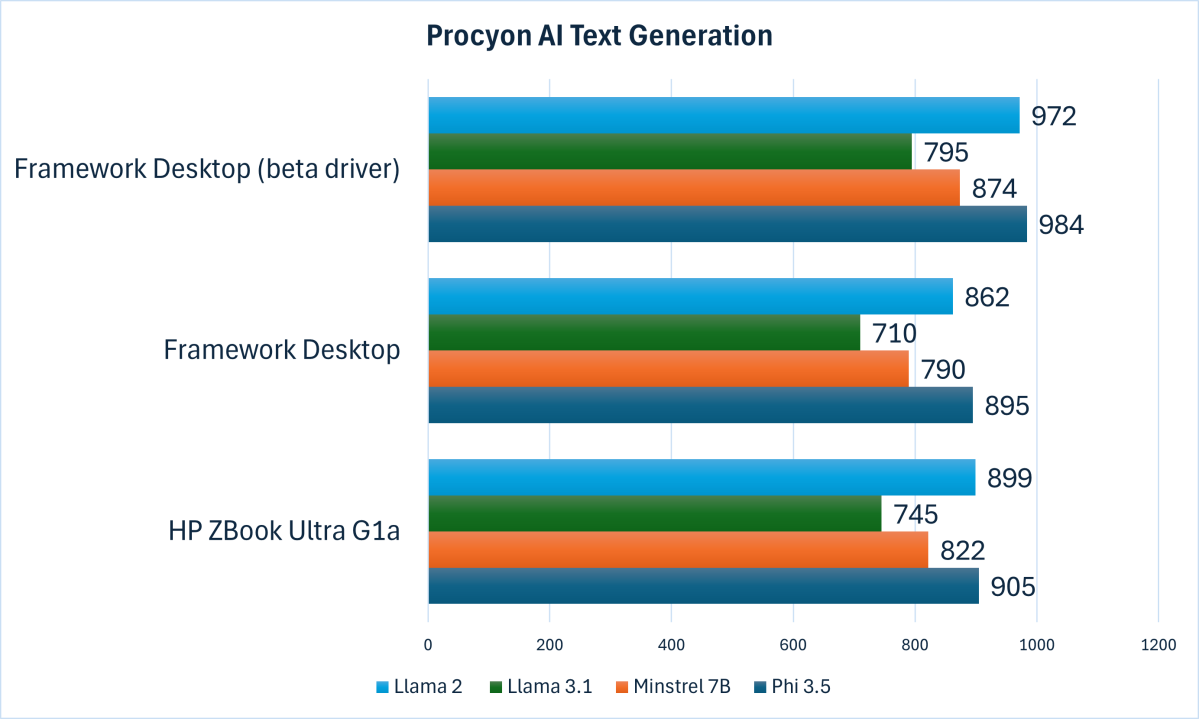
Mark Hachman / Foundry
I didn’t have all of the devices available to me to run this benchmark, which approximates an AI chatbot / LLM, running four relatively old models. The test measures the speed of the output, asking similar questions or prompting similar tasks.
This benchmark was pretty close using Framework’s driver, but with the improved AMD driver the performance jump on the Phi 3.5 benchmark increases just 8.7 percent. Generally speaking, chatbot performance is probably going to be pretty similar across these devices, even those we didn’t test.
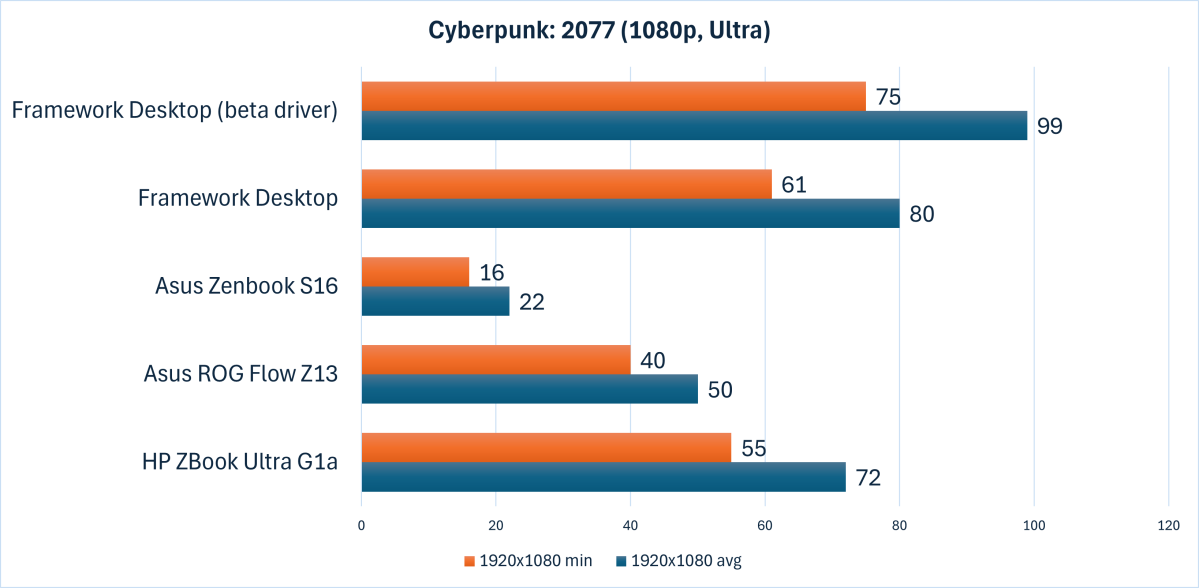
Mark Hachman / Foundry
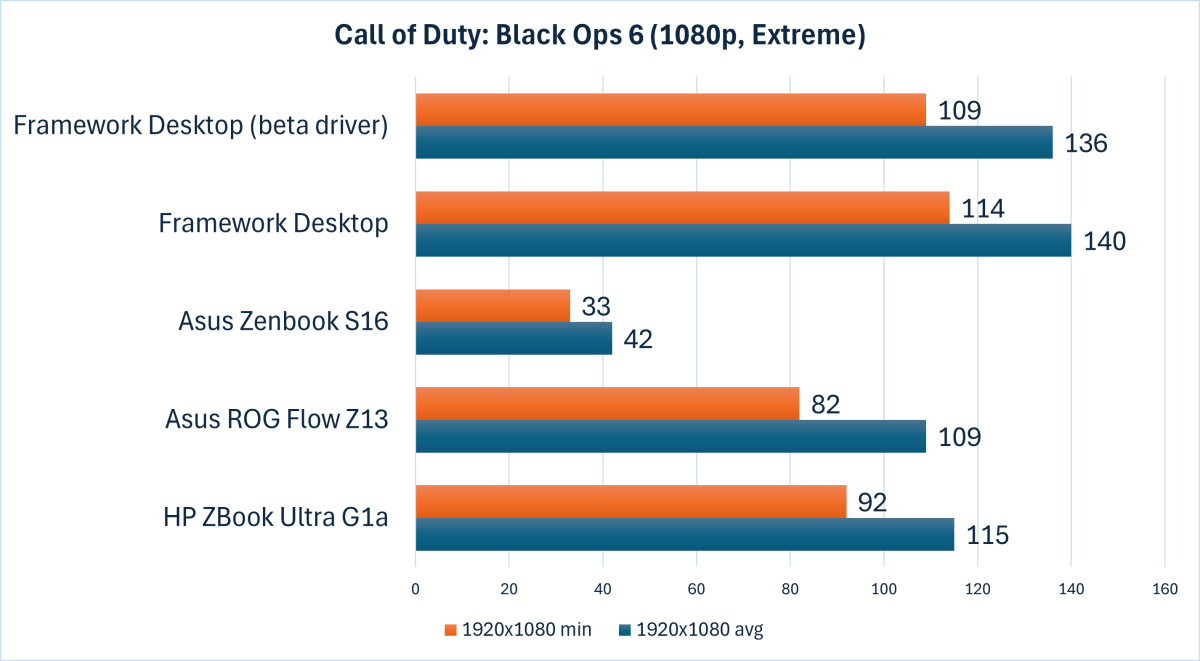
Mark Hachman / Foundry
We’ll have some more gaming benchmarks a bit lower down, but these two games indicate that gaming is certainly possible at high levels on the Framework Desktop. We’re showing here both average framerates as well as the “minimum” one percent framerates, indicating that if and when your game stutters, even a framerate drop will put it at playable levels. Most gamers consider 60 fps to be the absolute minimum, with above 90 fps preferred.
At over 90 fps for both games at the highest visual settings, both of these relatively recent games are certainly playable on this PC.
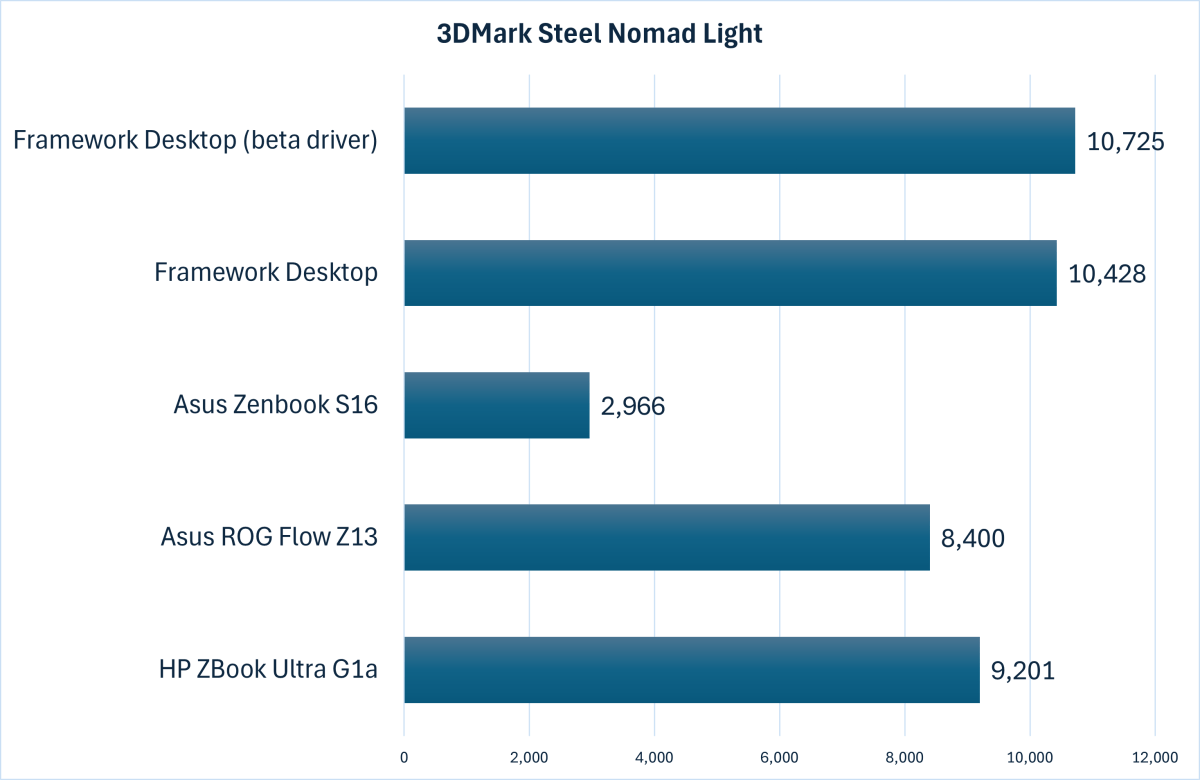
Mark Hachman / Foundry
For other games, we use 3DMark’s benchmarks as a proxy for how well the system will perform.
In this case, developer UL recommends that we use the Steel Nomad Light benchmark as the appropriate one for this hardware. Here, the Framework Desktop demonstrates a 16.5 percent increase versus the HP ZBook.
Next, we compared the Framework Desktop to a number of gaming laptops. Again, the purpose here was not to ascertain whether the Framework Desktop was the best in any particular category, but to give you a sense for where the Desktop and its Strix Halo chip stands in terms of hardware that you already know and understand.
For this, we compared the Desktop to the $1,499 Alienware 16 Aurora, which uses a Core 7 240H chip on Intel’s Raptor Lake architecture, and a Nvidia GeForce RTX5060; as well as two Intel “Arrow Lake” notebooks. The first, the $3,299 Asus ROG Strix Scar 16, contains a Core Ultra 9 275HX and an RTX 5080. The other, the $4,499 MSI Raider 18 HX A2XW, includes a Core Ultra 9 285HX and an RTX 5080 as well, and is one of the fastest notebooks we’ve seen.
Finally, we’ve added the slower $1,199.99 Dell G15 with an Intel Core i7-13650HX chip and an RTX 4060 chip inside, plus the $2,699 Razer Blade 14 with an AMD Ryzen AI 9 365 CPU and an RTX 5070 GPU.
The AMD Ryzen Max+ 395 includes 16 cores and 32 threads, and runs up to 5.1GHz in the turbo mode. That actually puts it ahead of the Core Ultra 9 inside the MSI Raider, which has 24 cores and 24 threads. The difference is that those threads run up to speeds of 5.5GHz, probably giving the Raider the edge here.
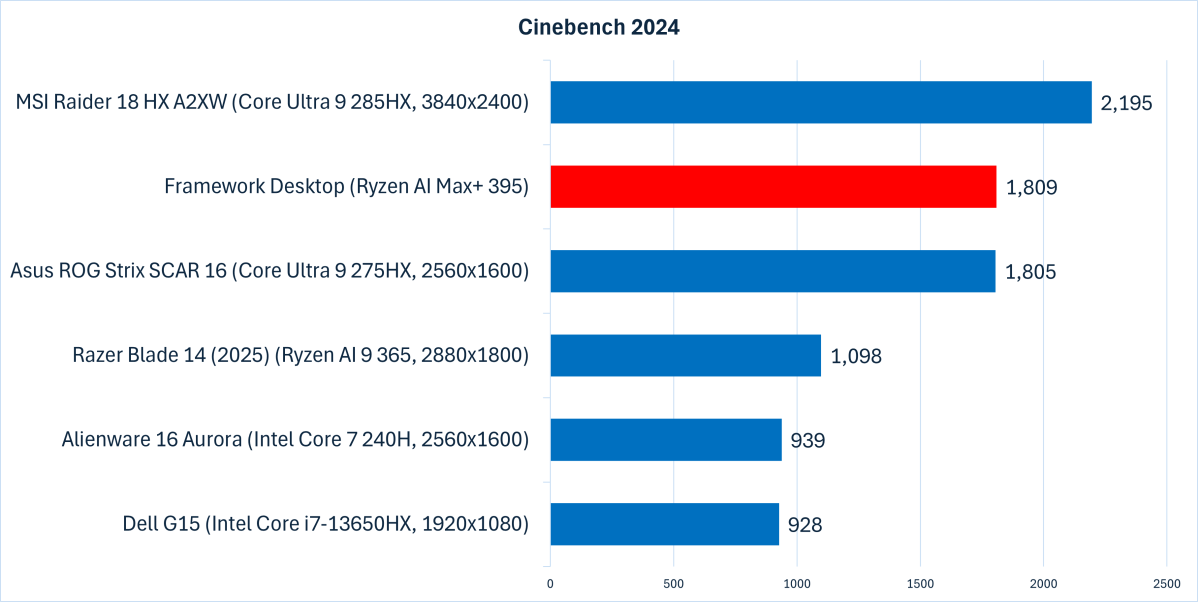
Mark Hachman / Foundry
We typically, choose PCMark 10 as our “how well will this system perform everyday tasks?” test. It’s a conglomerate of tests ranging from video chat to web browsing, office work, with functions like CAD thrown in for good measure. Most laptops and desktops excel here, but the additional “heavier” tasks like CAD can drag down underperforming systems.
There are no issues here. In general work, the Framework Desktop will be one of the fastest machines on the planet.
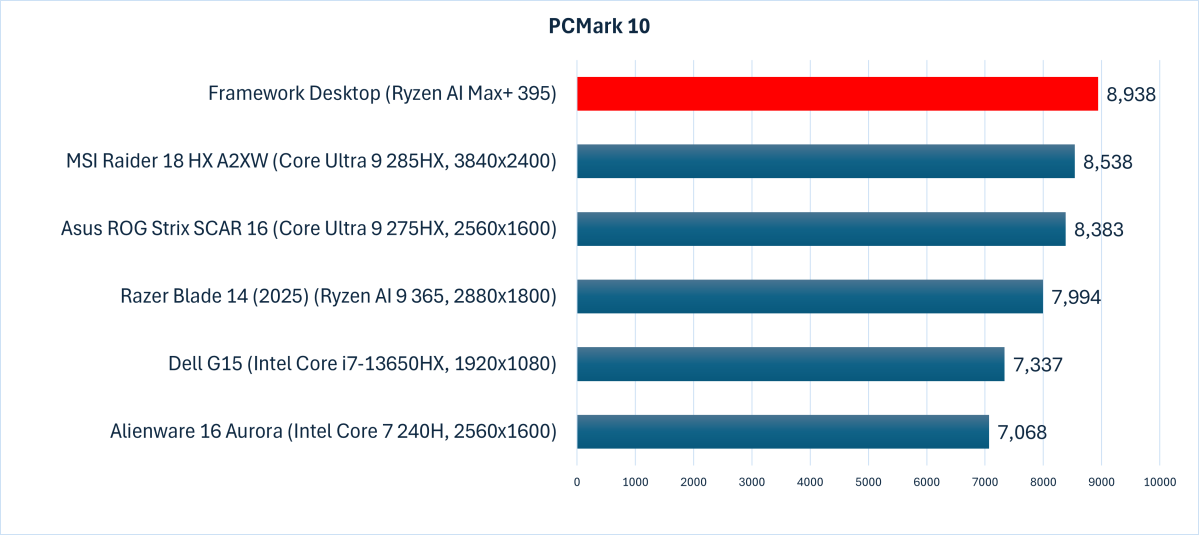
Mark Hachman / Foundry
Handbrake converts a feature-length film of about 90 minutes into a format suitable for a tablet. It’s an outdated benchmark from the standpoint that streaming is common on airplanes and elsewhere. But Handbrake still pushes all of the CPU cores to their limit, and does so as a test of their prolonged performance.
Note that there are many more recent and optimized versions of Handbrake which will deliver improved performance, but we use the older version for consistency’s sake. Here, the Desktop still performs well.

Mark Hachman / Foundry
As expected, we’ve included the results of two difference games to complement the gaming results we published above.
By now, Metro: Exodus may be six years old, but the engine punishes old and new GPUs alike. It’s worth noting that we’ve turned off frame generation and upscaling for these, providing (in the words of my colleague Adam Patrick Murray) “farm to table frames” that measure exactly what these GPUs can render.
The Framework Desktop can’t achieve what most gamers consider to be the minimal 60 fps that makes a game playable, and it falls to the bottom of the rankings. Still, for an all-around solution like AMD’s Strix Halo chip, it’s impressive.

Mark Hachman / Foundry
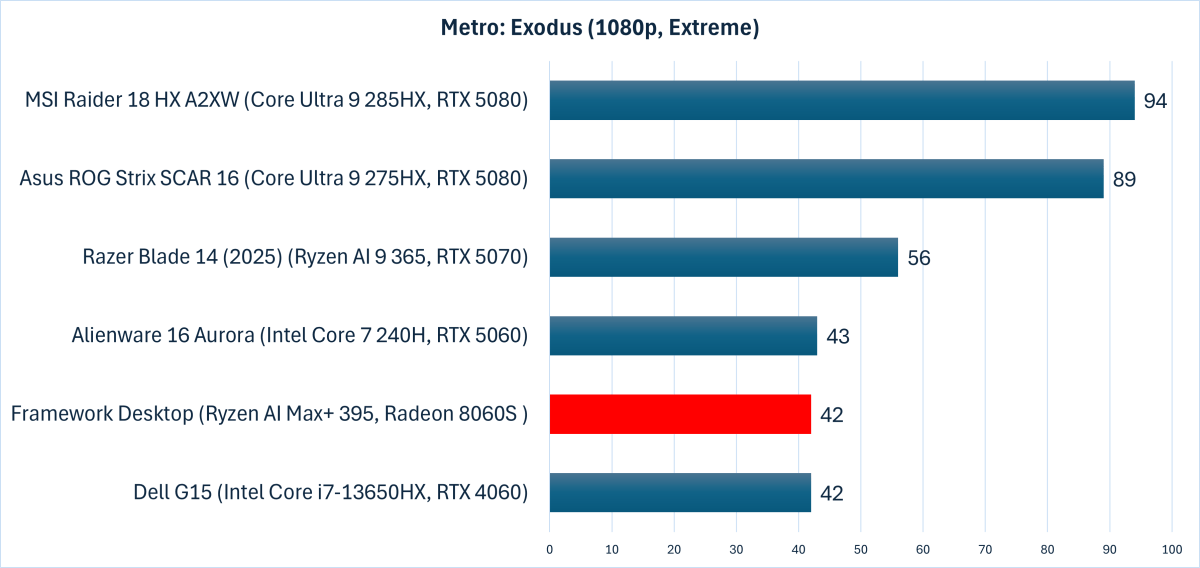
Mark Hachman / Foundry
One of the key reasons to consider a Framework Desktop, however, is that it lends itself to the use of AI. Here, the performance matters to some extent, but it’s the size of the model that makes it particularly attractive. Since the massive amount of available VRAM can be allocated to loading and storing the AI model, our Desktop review unit can load models others can’t.
A local AI model is private, and doesn’t suffer from any restrictions on how many times you can ask questions. You can download whatever models will fit within the memory limitation, and train them to answer your own personal questions.
As it turns out, two models debuted late in our testing period: Meta’s Llama 4 Scout 109B (109 billion parameters) model, a 67GB download, and the first OpenAI model to run locally, known as OpenAI-gpt-oss 20B (20 billion parameters), which took up 11.3 GB of space.
When providing a sample query (“How much wood could a woodchuck chuck if a woodchuck could chuck wood? Be explicit, and let’s pretend that only pine trees are used.”) the Llama 4 Scout model generated 12.64 tokens per second, with 0.62 seconds to first token. OpenAI’s model was much faster, at 53.9 tokens per second, and 2.27 seconds to the first token.
What do these numbers mean? An AI prints text like a dot-matrix printer, spitting out line by line. How acceptable the speed is depends on how quickly you read: as a fast reader, 12 tokens per second is fast enough. The time to first token is how long a model “thinks” before generating its response.
In general, AI models with more parameters tend to give better, more creative responses, though there’s some variation in that depending on how it’s trained. Smaller models tend to give simpler responses. I tended to like OpenAI’s responses better, as Meta’s needed a bit of followup at times.
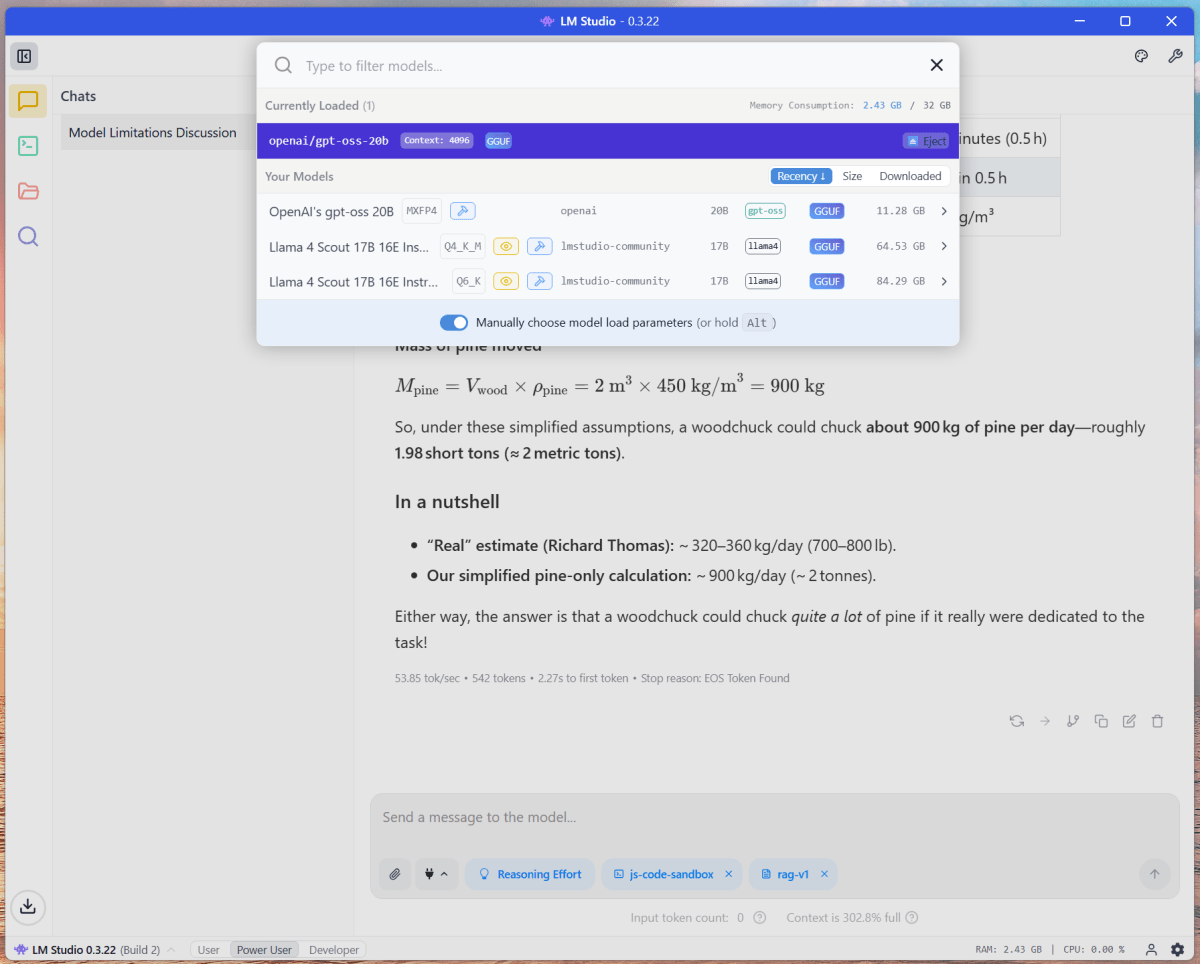
Mark Hachman / Foundry
Framework Desktop: Conclusion
You will always be able to put together a PC with exactly the components you wish, and aggressively shop for each one. Laptops are certainly an effective use of the space, and include a display to boot.
But there’s something I really love inside the Framework Desktop. Yes, Framework soldered down the memory, which is a drawback compared to, well, most of the competition. But I was very charmed by the care and detail Framework put into the assembly process, complete with the personal touch that the tiles offer.
Yet the Desktop isn’t just a gimmick, either. When I reviewed the Asus ROG gaming tablet with a similar AMD “Strix Halo” chip inside, I struggled to understand why Asus chose a tablet over a clamshell, or even better, a desktop. The Framework Desktop is what I think we all wanted: a compact, small-form-factor desktop that packs serious power and can be used for productivity, gaming, and AI alike.
Should I use the term “love” here? I almost want to. Failing that, there’s a sense of thoughtfulness that’s rarer today than ever. The Desktop feels like a product designed for someone that wants to make that leap into becoming a tech enthusiast, with just a little help getting over the hump. Could a parent build a Desktop with their child? Absolutely.
I very much enjoyed my time with the Framework Desktop. If you choose to buy the Framework Desktop, I think you’ve made a smart and enjoyable decision.






